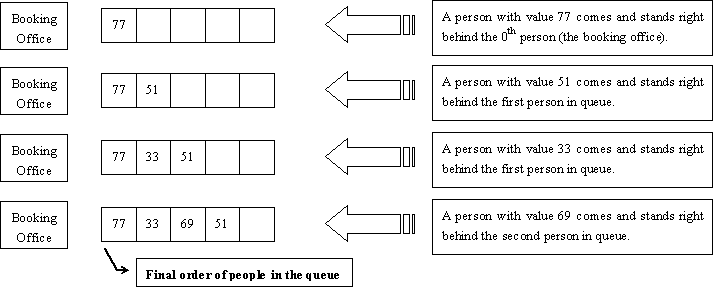Buy Tickets
Railway tickets were difficult to buy around the Lunar New Year in China, so we must get up early and join a long queue…
The Lunar New Year was approaching, but unluckily the Little Cat still had schedules going here and there. Now, he had to travel by train to Mianyang, Sichuan Province for the winter camp selection of the national team of Olympiad in Informatics.
It was one o’clock a.m. and dark outside. Chill wind from the northwest did not scare off the people in the queue. The cold night gave the Little Cat a shiver. Why not find a problem to think about? That was none the less better than freezing to death!
People kept jumping the queue. Since it was too dark around, such moves would not be discovered even by the people adjacent to the queue-jumpers. “If every person in the queue is assigned an integral value and all the information about those who have jumped the queue and where they stand after queue-jumping is given, can I find out the final order of people in the queue?” Thought the Little Cat.
Input
There will be several test cases in the input. Each test case consists of N + 1 lines where N (1 ≤ N ≤ 200,000) is given in the first line of the test case. The next N lines contain the pairs of values Posi and Vali in the increasing order of i(1 ≤ i ≤ N). For each i, the ranges and meanings of Posi and Vali are as follows:
- Posi ∈ [0, i − 1] — The i-th person came to the queue and stood right behind the Posi-th person in the queue. The booking office was considered the 0th person and the person at the front of the queue was considered the first person in the queue.
- Vali ∈ [0, 32767] — The i-th person was assigned the value Vali.
There no blank lines between test cases. Proceed to the end of input.
Output
For each test cases, output a single line of space-separated integers which are the values of people in the order they stand in the queue.
Sample Input
4 0 77 1 51 1 33 2 69 4 0 20523 1 19243 1 3890 0 31492
Sample Output
77 33 69 51 31492 20523 3890 19243
Hint
The figure below shows how the Little Cat found out the final order of people in the queue described in the first test case of the sample input.

题目链接: http://poj.org/problem?id=2828
题目大意:有n个人插队, 每次插队 x y 编号为y的人查到第x个人后面,问最后的排序
思路:每次插入人 x y时, 找到第 i 个人,把它转到根,然后把这个新的节点当做根节点接上去。维护左儿子在当前节点前面,右儿子在当前节点后面。所以输出的时候dfs中序遍历的顺序就是最后的顺序。
然后很神奇的一点是用G++会TE,C++才能过,我也不知道为什么
代码:
#include<stdio.h>
#include<string.h>
#include<algorithm>
using namespace std;
const int N=200005;
int ch[N][2],f[N],siz[N],id[N];
int sz,root;
void clear(int x) {ch[x][0]=ch[x][1]=f[x]=siz[x]=id[x]=0; }
int get(int x){return ch[f[x]][1]==x; }
void update(int x)
{
if(x)
{
siz[x]=1;
if(ch[x][0]) siz[x]+=siz[ch[x][0]];
if(ch[x][1]) siz[x]+=siz[ch[x][1]];
}
}
void rot(int x)
{
int old=f[x],oldf=f[old],w=get(x);
ch[old][w]=ch[x][w^1];f[ch[old][w]]=old;
ch[x][w^1]=old;f[old]=x;f[x]=oldf;
if(oldf) ch[oldf][ch[oldf][1]==old]=x;
update(old);update(x);
}
void splay(int x)
{
for(int fa;fa=f[x];rot(x))
if(f[fa]) rot(get(x)==get(fa)?fa:x);
root=x;
}
int findx(int x) //找到排在第x个的点
{
int now=root;
while(1)
{
if(ch[now][0]&&x<=siz[ch[now][0]]) now=ch[now][0];
else
{
int tmp=(ch[now][0]?siz[ch[now][0]]:0)+1;
if(x<=tmp) return now;
x-=tmp; now=ch[now][1];
}
}
}
void Insert(int x,int y)
{
clear(sz+1);
if(root==0) {sz++;ch[sz][0]=ch[sz][1]=f[sz]=0;root=sz;siz[sz]=1;id[sz]=y;return; }
if(x==0) //如果排在最前面,找到最左的节点,作为其左儿子
{
int now=root;
while(ch[now][0]) now=ch[now][0];
sz++;
ch[sz][0]=ch[sz][1]=0;
f[sz]=now; siz[sz]=1;
id[sz]=y;
update(now); splay(sz);
return;
}
int now=findx(x);
splay(now);
sz++;
f[now]=sz; ch[sz][0]=now;
ch[sz][1]=ch[now][1];f[ch[sz][1]]=sz;
ch[now][1]=0;
id[sz]=y;
root=sz;
update(now);update(sz);
return;
}
void dfs(int u)
{
if(u)
{
if(ch[u][0]) dfs(ch[u][0]);
printf("%d ",id[u]);
if(ch[u][1]) dfs(ch[u][1]);
}
}
int main()
{
int n;
while(~scanf("%d",&n))
{
sz=root=0;
int x,y;
for(int i=0;i<n;i++)
{
scanf("%d%d",&x,&y);
Insert(x,y);
}
dfs(root);
printf("\n");
}
return 0;
}





 本文介绍了一种模拟春运期间购票排队的算法,通过构建一种特殊的数据结构,实现了动态的队伍管理,包括人员插队和最终队伍顺序的确定。算法巧妙地解决了在黑暗环境下人们插队不易被发现的问题,通过一系列操作,如旋转和查找,确保了最终输出的队伍顺序正确无误。
本文介绍了一种模拟春运期间购票排队的算法,通过构建一种特殊的数据结构,实现了动态的队伍管理,包括人员插队和最终队伍顺序的确定。算法巧妙地解决了在黑暗环境下人们插队不易被发现的问题,通过一系列操作,如旋转和查找,确保了最终输出的队伍顺序正确无误。
















 226
226

 被折叠的 条评论
为什么被折叠?
被折叠的 条评论
为什么被折叠?








